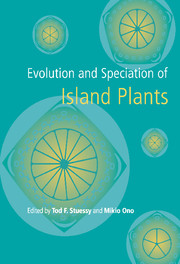Book contents
- Frontmatter
- Contents
- List of contributors
- Preface
- Acknowledgements
- Part one Hawaiian Islands
- Introduction
- 1 Chromosome evolution and speciation in Hawaiian flowering plants
- 2 Evolution in the endemic Hawaiian Compositae
- Part two Juan Fernandez Islands
- Part three Southern and western Pacific Islands
- Part four General evolutionary patterns and processes on oceanic islands
- Author index
- Taxon index
- Subject index
2 - Evolution in the endemic Hawaiian Compositae
Published online by Cambridge University Press: 04 May 2010
- Frontmatter
- Contents
- List of contributors
- Preface
- Acknowledgements
- Part one Hawaiian Islands
- Introduction
- 1 Chromosome evolution and speciation in Hawaiian flowering plants
- 2 Evolution in the endemic Hawaiian Compositae
- Part two Juan Fernandez Islands
- Part three Southern and western Pacific Islands
- Part four General evolutionary patterns and processes on oceanic islands
- Author index
- Taxon index
- Subject index
Summary
Abstract
All but one or two indigenous species of Compositae on the Hawaiian Islands are endemic to the archipelago, the descendants of ten founder species. Five of the ten endemic lineages (the silversword alliance, Bidens, Lipochaeta sect. Aphanopappus, Lipochaeta sect. Lipochaeta and Tetramolopium) comprise 77 of the 90 endemic species of Hawaiian Compositae and have been regarded as examples of adaptive radiation. The great breadth of morphological and ecological variation in the silversword alliance and Hawaiian Bidens, the two largest groups, is exceptional for insular floras worldwide. Biosystematic and molecular evolutionary data have revealed high genetic similarity between species and lack of effective sterility barriers in each of the five major groups of endemic Hawaiian Compositae, consistent with the young age of the lineages and the long-persistent, woody life-forms of most species. Most species of Hawaiian Compositae are self-compatible, but exceptional breeding system diversity exists, in part associated with selection for outcrossing, with self-incompatibility in the silversword alliance, gynodioecy in Hawaiian Bidens, and gynomonoecy and monoecy in Hawaiian Tetramolopium. Phylogenetic comparisons between the silversword alliance and Hawaiian Tetramolopium show contrasting patterns of adaptive shifts, with recurrent transformations in life-form and habitat preferences in different lineages of the silversword alliance, and a minimal number and narrower range of such transformations in the younger Hawaiian Tetramolopium group. The extent to which lineage size and numbers of major evolutionary shifts in Hawaiian Compositae are attributable to lineage age, origin of key innovations or ‘preadaptations’ is uncertain.
- Type
- Chapter
- Information
- Evolution and Speciation of Island Plants , pp. 49 - 74Publisher: Cambridge University PressPrint publication year: 1998
- 9
- Cited by



